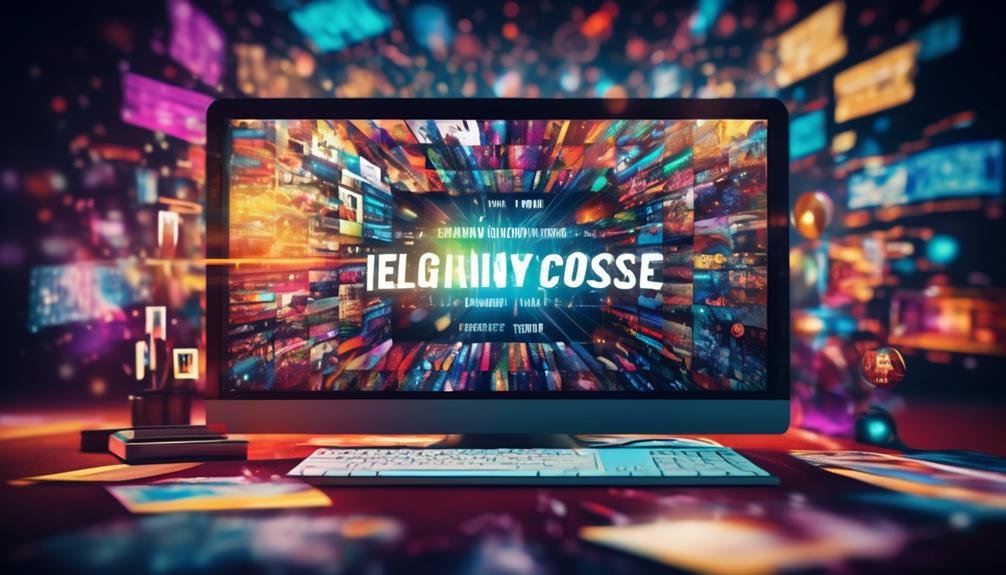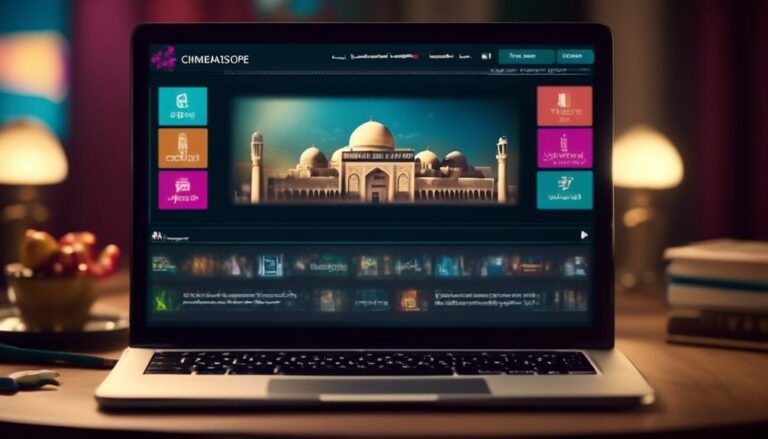Top Rated Online Graphic Design Courses for Creatives
So, you've dabbled in the world of graphic design, and now you're ready to take your skills to the next level. You might have scoured the internet for online courses, only to be bombarded with countless options, making it difficult to discern the top-rated ones.
Well, fear not, because we've curated a list of the most highly acclaimed online graphic design courses that have been making waves in the creative community. These courses cover everything from the fundamentals of design to advanced techniques, and they just might be the catalyst you need to elevate your design game to new heights.
Key Takeaways
- Beginner graphic design courses cover fundamental design principles and teach software skills like Adobe Photoshop, Illustrator, and InDesign.
- Advanced graphic design techniques focus on visual hierarchy, font pairings, grid systems, and achieving visual balance to enhance the impact of designs.
- Color theory and application explore the psychology of color, effective ways to apply color, and using colors intentionally to communicate with the audience.
- Logo and brand identity design involve adhering to design principles, employing visual storytelling techniques, and creating memorable and impactful logos.
Beginner Graphic Design Courses
If you're new to graphic design, you can explore beginner courses that provide a solid foundation in design principles and software skills. These courses are tailored to introduce you to design software like Adobe Photoshop, Illustrator, and InDesign, essential tools for creating stunning visual communication materials.
Through hands-on projects and tutorials, you'll learn how to manipulate images, create illustrations, and design layouts to effectively convey messages. The beginner courses also cover the basics of color theory, typography, and composition, giving you a comprehensive understanding of the principles that underpin successful graphic design.
Advanced Typography and Layout Design
Exploring advanced typography and layout design techniques will enhance your ability to create visually impactful and professionally polished graphic designs. Understanding visual hierarchy and font pairings is crucial for conveying information effectively. Additionally, mastering grid systems and visual balance will give your designs a structured and harmonious look. Here's a breakdown of the key concepts you'll delve into when exploring advanced typography and layout design:
| Advanced Typography and Layout Design |
|---|
| Visual Hierarchy |
| Font Pairings |
| Grid Systems |
| Visual Balance |
Color Theory and Application
Now let's talk about color theory and application. You'll learn about the basics of color psychology and how it influences design.
Additionally, you'll explore practical ways to apply color effectively in your graphic design projects.
Color Psychology Basics
Understanding the basics of color psychology is essential for effective color theory and application in graphic design. Color symbolism and emotional impact play a significant role in how audiences perceive and interact with visual content. By utilizing the principles of color psychology, graphic designers can evoke specific emotions, convey messages, and create visually appealing designs that resonate with viewers. Here's a brief overview of how different colors are commonly perceived:
| Color | Symbolism | Emotional Impact |
|---|---|---|
| Red | Passion, energy | Excitement, urgency |
| Blue | Trust, stability | Calmness, trust |
| Yellow | Happiness, optimism | Cheerfulness, warmth |
| Green | Nature, growth | Relaxation, harmony |
Understanding the psychological effects of colors empowers designers to make intentional choices that effectively communicate and connect with their audience.
Practical Color Applications
To effectively apply color theory in graphic design, it's essential to understand the principles of color psychology. By delving into practical color applications, you can consider color mixing techniques and visual perception. Mastering these techniques allows you to create harmonious color schemes and captivating visuals.
In addition, understanding color symbolism and cultural influences is imperative. Different colors hold various meanings across cultures, and being aware of these associations helps you communicate your intended message effectively. By incorporating these aspects into your design process, you can create designs that look aesthetically pleasing and convey the right emotions and messages to your audience.
Logo and Brand Identity Design
Designing a memorable logo and crafting a strong brand identity are essential components of effective graphic design. When creating logos, it's crucial to adhere to logo design principles and employ visual storytelling techniques to ensure that the logo communicates the brand's message and values effectively.
| Logo Design Principles | Visual Storytelling Techniques |
|---|---|
| Simplicity | Use of color psychology |
| Versatility | Incorporating symbolism |
| Memorability | Typography choices |
| Timelessness | Creating a narrative |
These principles and techniques guide the process of developing logos that resonate with the audience and leave a lasting impression. By focusing on simplicity, versatility, memorability, and timelessness, you can ensure that the logo remains impactful and relevant over time. Additionally, utilizing visual storytelling techniques such as color psychology, symbolism, typography choices, and creating a narrative within the logo can evoke emotional connections and convey the brand's story effectively. Mastering these elements is crucial for any graphic designer looking to specialize in logo and brand identity design.
Web and UI/UX Design Fundamentals
When delving into the fundamentals of web and UI/UX design, it's essential to grasp the principles of user-centered design and its impact on creating intuitive digital experiences. Understanding web design principles and the creation of interactive user experiences is crucial for crafting compelling and user-friendly websites and applications.
Here are four key concepts to focus on:
- User-Centered Design: Prioritizing the needs and preferences of the end user is at the core of effective web and UI/UX design. By aligning design decisions with user expectations, you can create interfaces that are intuitive and easy to navigate.
- Visual Hierarchy: Organizing content in a visually appealing and easily scannable manner helps guide users through the interface. Implementing visual hierarchy ensures that important elements stand out and that the overall layout is visually balanced.
- Responsive Design: With the growing diversity of devices used to access the web, it's essential to design interfaces that adapt seamlessly to various screen sizes. Responsive design allows for an optimal viewing experience across different devices.
- Usability Testing: Conducting usability tests and gathering feedback from real users are integral parts of creating an interactive user experience. Testing helps identify areas for improvement and ensures that the design meets the needs of the target audience.
Motion Graphics and Animation
After mastering the fundamentals of web and UI/UX design, you can now explore the dynamic realm of motion graphics and animation for creating captivating visual experiences.
Character animation techniques play a vital role in bringing life to illustrations and storytelling. Learning how to make characters move in a believable and compelling way is essential for creating engaging narratives in animated videos.
Additionally, understanding kinetic typography principles is crucial for adding an extra layer of creativity to your designs. Kinetic typography involves the animation of text, allowing words to move, change, and transition in sync with the audio, bringing a powerful visual impact to motion graphics.
Portfolio Building and Freelancing Tips
You can enhance your prospects as a graphic designer by developing a strong portfolio and implementing effective freelancing strategies. Building a portfolio and leveraging freelance opportunities are crucial for establishing yourself in the graphic design industry. Here are some tips to help you succeed in portfolio building and freelancing:
- Showcase Diverse Work: Ensure your portfolio reflects a variety of projects, demonstrating your versatility in different design styles and mediums. This can attract a wider range of potential clients and showcase your adaptability.
- Highlight Your Best Work: Curate your portfolio to feature your most impressive and relevant projects. Quality over quantity is key, so focus on showcasing your strongest pieces to make a lasting impression.
- Seek Client Testimonials: Request feedback from satisfied clients to add credibility to your portfolio. Testimonials can reassure potential clients of your skills and professionalism, increasing your chances of securing freelance opportunities.
- Network and Market Yourself: Actively engage in networking events, social media, and online platforms to promote your work and connect with potential clients. Building a strong online presence can help you attract freelance opportunities and expand your professional network.
Conclusion
You've just unlocked the door to a world of creativity and opportunity.
Did you know that 67% of small businesses believe that design is essential to their success?
With the top-rated online graphic design courses, you're equipped with the skills and knowledge to make a significant impact in the industry.
So what're you waiting for?
Start your journey to becoming a successful graphic designer today!







